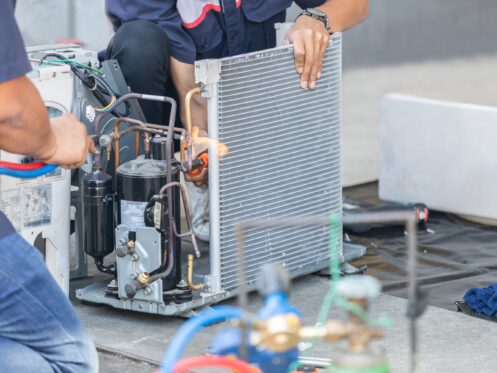Installing a new air conditioner is a big step toward better comfort and improved energy efficiency. If you’re thinking about upgrading your system, one of the first questions you might have is: How long will the installation take? The truth is, the timeline can vary depending on a few key factors.
At KW Lang Mechanical, we proudly serve homeowners across the Cleveland area, and we believe in setting clear expectations from the start. Knowing what can impact the AC installation process helps you plan ahead with confidence.
Pre-Installation Considerations
Before we begin the installation, we’ll evaluate your current setup. If you’re replacing an existing system, we’ll inspect the ductwork, test airflow, and check the electrical system. This initial step is crucial for helping you select the right type and size of air conditioner.
Another potential factor is permitting. In many cities, a permit is required for HVAC replacements. While our team handles the permitting paperwork, approval times can vary depending on local jurisdiction and the time of year.
System Type and Configuration
The type of system you choose can significantly impact the installation process. Replacing your existing HVAC unit with a similar size and configuration usually results in a quicker installation since the infrastructure is already in place.
However, if your home lacks ductwork or requires electrical upgrades, installation will take longer. Complete HVAC overhauls may also involve additional planning, especially if transitioning from a traditional system to ductless mini-splits or heat pump technology.
Condition of Existing Ductwork
If your home has existing ductwork, we’ll assess whether it needs minor repairs, sealing, or cleaning. However, if the ductwork is outdated, undersized, or poorly routed, it may need to be replaced or redesigned before the new AC system is installed.
Accessibility and Layout Challenges
Every home presents unique challenges. For example, installing an air conditioner in a single-story home typically takes less time than in a multi-story property. Tight crawlspaces, complex attic layouts, or long distances between the indoor and outdoor units can increase installation time.
Additional steps — like installing a raised platform for the outdoor condenser or upgrading the electrical panel — can also affect the project timeline. Weather conditions, especially heavy rain or extreme heat, may delay outdoor work or slow down progress.
Electrical and Refrigerant Work
Connecting the electrical wiring and refrigerant lines is a critical part of the job. If your home has outdated or insufficient wiring, we may need to install dedicated circuits or upgrade your electrical panel.
Charging the system with refrigerant must be done carefully. Our EPA-certified technicians ensure proper handling, correct charge levels, and leak testing in compliance with federal guidelines.
Post-Installation Testing and Calibration
Once the system is installed, we perform several quality checks to ensure optimal performance.
- Running the air conditioner through multiple cycles
- Testing temperature differentials
- Checking system airflow and pressure levels
- Calibrating the thermostat
- Providing a full walkthrough with the homeowner
We’ll also make any necessary fine-tuning adjustments and ensure you’re comfortable operating your new system. Call our cooling services team if you have more questions or want to explore options for new, energy-efficient air conditioners.





